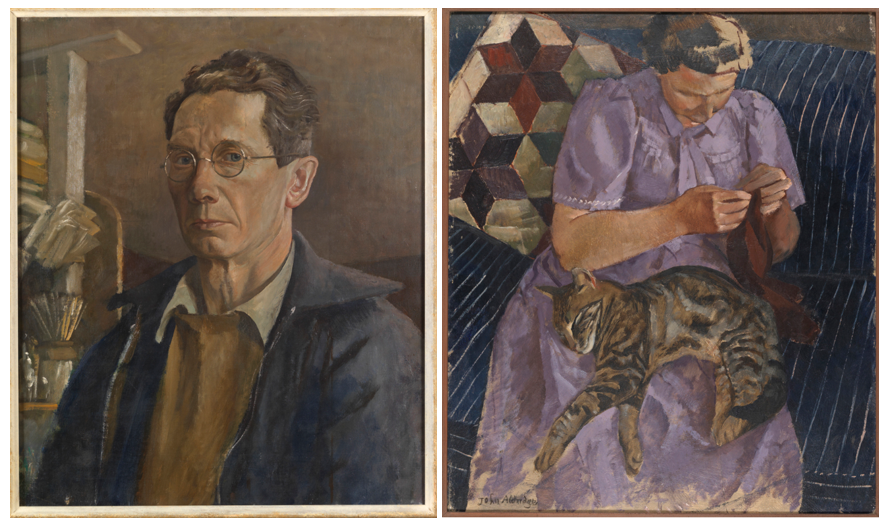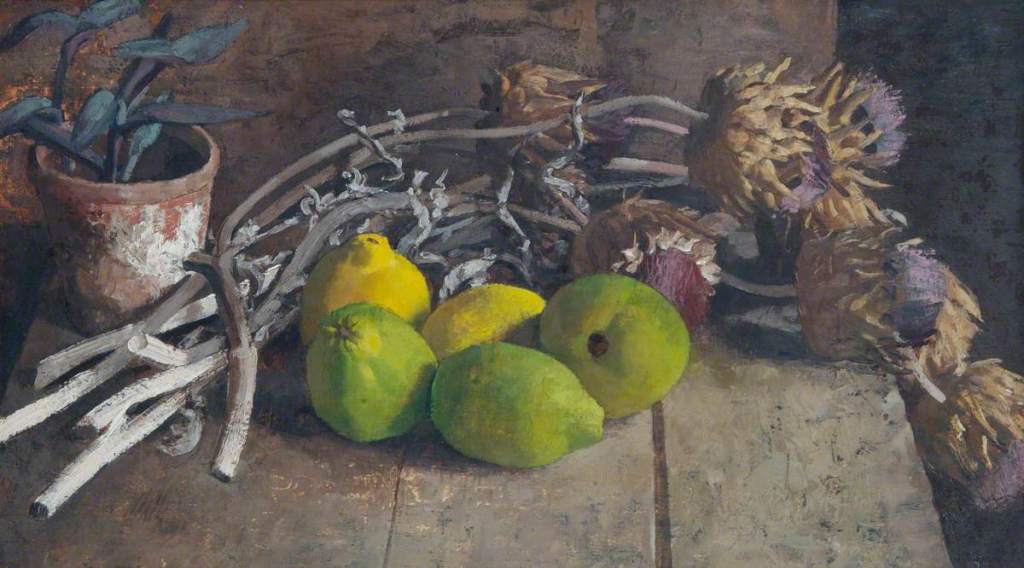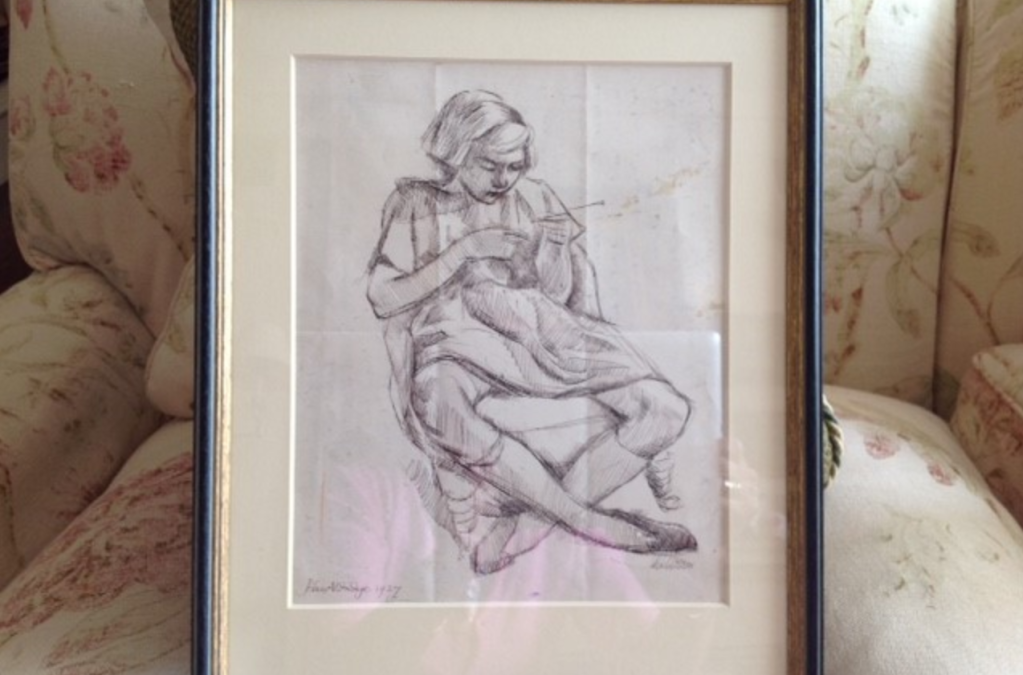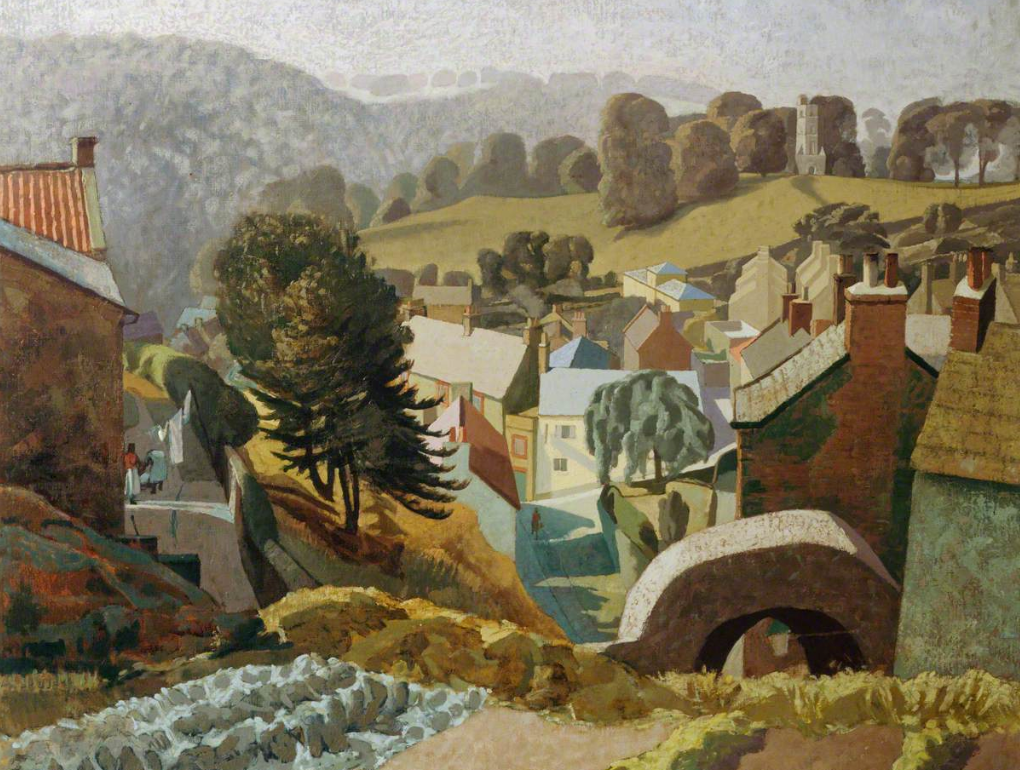
John Aldridge was my grandmother’s half-brother and has always been known to me as Uncle John. He was a painter, designer and book illustrator, active from the 1930s until his death in 1983. Although not very well-known, he worked for many years alongside Eric Ravilious and Edward Bawden, two artists who are more or less established in the national consciousness.
My mother and her siblings knew John when he was an older man, by then a semi-establishment figure, a teacher of young artists at The Slade and a member of the Royal Academy.
The family walls are plastered with his work, some paintings and many drawings, most of them rescued from old folders that were discovered after my grandmother’s death.
John was said to have been a kind and gentle soul. Attractive, erudite and very intelligent, he studied the Classics (or ‘The Greats’ as it was then called) at Oxford. Here he was associated with the ‘Corpus Aesthetes’ who lived out the kind of poetic but mannered existence portrayed in Evelyn Waugh’s Brideshead Revisited.
He never took any painting instruction and was entirely self-taught.
In 1933, aged 28, encouraged by Cedric Morris, he moved to the village of Great Bardfield in the Essex countryside, and acquired a beautiful old, haunted house, where he lived for the rest of his life. He became friends with Edward Bawden and the two artists collaborated in designing ‘Bardfield’ wallpapers, which was a success until the war put a stop to production. At this time Great Bardfield was host to a real community of artists including Eric Ravilious and Tirzah Garwood.

Uncle John never had any children, something that he apparently regretted deeply. He had married a woman who was sixteen years older than him and eventually left her for Gretl Cameron, the Austrian widow of his friend, the poet Norman Cameron. The events caused trouble in the village, the vicar cut him off socially and it effectively brought an end to his friendship with Bawden.
For many years Lucie, his wife (above right), refused to divorce him and this ultimately put a stop any chance of him and Gretl getting married and having children.
The stories I have heard suggest that the artists of Great Bardfield were up to no good in the early 1930s. Family rumour has it that Uncle John had legions of illicit affairs, including with the wives of Ravilious and Ben Nicolson.
I should add that he was almost certainly bi-sexual and (you heard it here first) possibly had an affair with Louis Armstrong.
At this time the international art world was centred on Paris, around the likes of Picasso, Magritte and Salvador Dali. It was common to say that England had no real modernist artists. The Great Bardfield set were clearly far removed from their Bohemian, radical neighbours in France, but tried to get attention for their work by exhibiting at the influential Leicester Galleries in Mayfair.
I would describe Uncle John’s work as intensely English, in an old-fashioned Orwellian way. His paintings almost radiate Englishness, the consciousness of being an islander, the lack of any Catholic spirit or intellectual pretensions and a love for landscape, gardens and flowers.
His art is a world away from the louder, unorthodox and much more influential artists in Paris who were at the forefront of a cultural Revolution.
At one moment Uncle John noticed that Picasso was including wine glasses in his pictures almost as a symbol of his lifestyle, so John started painting teacups and saucers into his own work (see below). This was his kind of discreet and subtle joke.



Uncle John wasn’t a sensational painter, but I love the simple lines, hazy atmosphere and radiant light of his landscapes, replete with rolling hills, bent trees and broken plant pots. He was a true artist in the sense he was incredibly observant and took delight in all manner of things. His sketches cover an enormous variety of life; cows grazing, his sister knitting, a dandelion he found in the ground.
He was a great friend of the poet Robert Graves and they spent endless holidays together in Mallorca near Deia (see watercolour below). He generally avoided painting people and yet his portrait of Graves (see below, on the right), today in the National Portrait Gallery, is possibly his greatest work and a truly outstanding character observation.



As you would expect, Uncle John lived in a house full of wonderful things, collections of pottery and various objects, and a large garden (see above) that he loved to paint and tend to.
To me, living in an England of endless tarmac motorways and shopping centres, fast food and manicured celebrities, Aldridge and his set epitomise a lost world, of a quieter, more modest country before the war blew those ancient cobwebs away.
Uncle John loved Italy. We have a beautiful landscape of the ramparts at Urbino in our kitchen at home. He would regularly travel round Italy with my grandparents in a Morris Traveller. My aunt described this car as like a piece of furniture with wood attachments. On one visit, when they stopped on the side of a busy road, he got out of the car and left his door open, in his typically vague, forgetful manner. Another car drove past and took the door off, which meant they had to drive around from then on without the door.



My aunt recalled his extraordinary, slender hands, his flexible thumbs that could bend in any direction. He was ambidextrous, he could draw well with both hands, and his party trick was to draw a perfect circle using both hands which would meet at the bottom.
He had a private income and this might have been his downfall. He wasn’t reliant on his art keeping him afloat and therefore never strived for success and artistic improvement like Ravilious and Bawden. He perhaps didn’t utilise all his talent and you can see that his output was quite uneven.
By the time my mother and her siblings knew him, he was getting on and his art was out of fashion. The detailed, almost-nostalgic pictures of the countryside by Ravilious, Bawden, Uncle John and the others were out-of-kilter with the swinging 60s and 70s that treated old England as an abomination that needed to be forgotten.
In recent years, there has been a mini-renaissance of interest in the Great Bardfield artists and even Uncle John has been reassessed. In 2013 the charming Fry Gallery in Saffron Walden had a small retrospective on him, which we all went to see. His auction prices have been rising, much to the annoyance of me and my sisters (anyone reading this, please don’t bid against us).
My aunt says she now regrets not paying more attention to Uncle John. To their younger selves he was an old man who painted unfashionable pictures. But looking back on his life with the benefit of time he was evidently very talented and had an appealing depth to him.
How typical of us to lament when it is too late. But at least he left behind these beautiful pictures so that we can continue to see the world through his eyes every now and then.


If you enjoy my posts you can subscribe to the blog by following the link at the bottom of the page and you will be sent an email when I post something new.
Thanks Milo, this is wonderful and I love his paintings. X
LikeLiked by 1 person
Thank you for the enjoyable post. My favourites of the works you have shown are ‘Stubble Field’ (particularly) and the Cedric Morris portrait- the the painting of the pot on the right of one of the interior/tablescapes is wonderful.
What a clever family you have.
Kind regards, Nicola Lawrence
LikeLike
Great and wonderful art
LikeLiked by 1 person
https://www.facebook.com/John-Aldridge-artist-and-friends-101740831961853/?view_public_for=101740831961853
LikeLike
Thank you for this – how wonderful!
LikeLike
Dear Milo, what an interesting article about your great uncle. I love his work and own three paintings. How lucky your family is to have had his sensibilities first hand.
LikeLike
Thank you. And glad you love and own his work as well!
LikeLike
Only just discovered this; fascinating; many thanks. I am mentioning him in the preface to a forthcoming book by one of my PhD students (on John Rothenstein) as one of the most over-looked British artists. I have acquired several of his drawings and a wonderful large watercolour/gouache of a villa interior in Frascati where he went with Bawden…. I’d love to correspond further if poss; my email is e.chaney@ucl.ac.uk
LikeLiked by 1 person